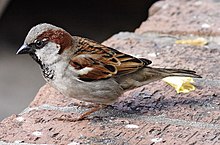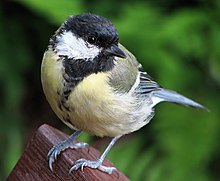Garden Birds Hour

The Garden Birds Hour is a bird watching event . It has been taking place in Germany since 2005 and in Switzerland since 2014. During this annual campaign in May, citizens are asked to write down the species and number of birds in a garden, from a balcony or in a park for an hour during the campaign period.
In Germany, the Garden Birds Hour is organized by the Naturschutzbund Deutschland (NABU) and the State Association for Bird Protection in Bavaria ; in Switzerland it is coordinated by the Swiss Bird Protection Organization SVS / BirdLife Switzerland . In 2021, the campaign will take place in Germany from May 13th to 16th. In Switzerland, the count took place in the previous week from May 5 to 9, 2021.
In addition to the hour of the garden birds, in Germany, Austria and some Swiss cantons an analogous bird census is carried out in January with the hour of the winter birds .
history
Among other things, the action was designed based on the model of the Big Garden Birdwatch , which, according to its own statements, is the world's largest bird-watching action , which has been carried out in Great Britain by the Royal Society for the Protection of Birds (RSPB) since 1979 .
In 2004, eight regional associations of the Nature Conservation Union in Germany started a forerunner campaign before a nationwide call for bird census in 2005. It is considered to be the largest bird watching campaign in Germany. In 2008 around 45,000 bird enthusiasts took part in the census, which recorded nearly one million birds in a total of 26,371 gardens. According to NABU, more than 120,000 people took part in the garden bird hour in 2020, when the blue tit was the focus, as its population experienced a decline due to Suttonella ornithocola .
The Garden Birds Hour has also been held in Switzerland since 2014. The organizer is the organization Schweizer Vogelschutz SVS / BirdLife Schweiz 2021, more than 4500 people, families and school classes took part; 136,277 birds from 163 species were observed.
In Germany, Austria and Switzerland there is also a similar campaign, the Birdrace , which is more aimed at ornithologists.

aims
According to the company, the aim of the campaign is to get a "Germany-wide and as accurate as possible picture of the bird life in our towns and villages."
The initiators do not lay claim to a scientifically exact recording of the real population of birds, as would, for example, be provided by raster mapping . The aim is to determine the long-term development of bird populations in gardens and parks in order to determine the proportions and trends of populations . In order to achieve representative results, the population data should be compared over several years. From this new knowledge can be gained about the development of individual bird species and their regional distribution.
The intention is not publicly stated to use the campaign to conduct public relations work in order to further spread the idea of bird protection in Germany.

Counting criteria
- Date: on three days in May (earlier on one day)
- Duration: one hour
- Counting: largest number of observations of a species at the same point in time during the observation period of one hour (not the total number of animals observed during one hour)
- Participants: one or more people in a garden or park
Results 2016
In 2016, over a million birds were recorded in over 27,000 gardens and parks in Germany. The following table shows the twenty most frequently observed animals:
| rank | Art | Total number | Share of gardens in percent |
|---|---|---|---|
| 1. | House sparrow | 130,633 | 64 |
| 2. | blackbird | 99,825 | 97 |
| 3. | Great tit | 85.103 | 86 |
| 4th | star | 72,243 | 53 |
| 5. | Blue tit | 68.010 | 77 |
| 6th | Tree Sparrow | 65,988 | 39 |
| 7th | magpie | 46,651 | 71 |
| 8th. | Greenfinch | 34,087 | 44 |
| 9. | Wood pigeon | 32,603 | 44 |
| 10. | Chaffinch | 31,946 | 49 |
| 11. | House martin | 29,187 | 18th |
| 12th | Common Swift | 27,766 | 20th |
| 13th | robin | 25,438 | 56 |
| 14th | Carrion crow | 23,783 | 29 |
| 15th | jay | 12,337 | 25th |
| 16. | Barn swallow | 12,107 | 9 |
| 17th | Turkish dove | 12.006 | 19th |
| 18th | great spotted woodpecker | 11,998 | 29 |
| 19th | Black redstart | 11,790 | 23 |
| 20th | Jackdaw | 10,065 | 8th |
criticism
The count can be influenced by a large number of error factors. A distinction must be made between error factors that are due to the general structure of the investigation (methodological errors) and those that can be assigned to the human factor.
In many cases, the determination is carried out by ornithological laypeople . They are more likely to confuse animals with other similar-looking birds (such as marsh and willow tits or fitis and chiffchaff ). On the other hand, birds are excluded from the statistics, which cannot be determined by them due to a lack of knowledge, identification books or poor observation conditions. This error could be demonstrated in the development of the figures for 2005 and 2006 after the number of magpies , house martins and common swifts observed had risen noticeably. The reason was that pictures of these animals were shown for the first time this year in the flyer at the hour of garden birds . To avoid this mistake in the future, it was decided to show the same 40 birds every year. It is also questionable whether the counting criteria are observed in every case, for example the requirement that not all birds are added that are sighted within an hour, but the highest number of birds that are sighted at any one time. After all, many lay ornithologists, unlike experts, will find it more difficult to identify birds that cannot be seen but heard by their voices.
In most cases, the observations are carried out in places that are characterized by the permanent presence of people. Nevertheless, in the rarest of cases, devices are used to ensure that people behave inconspicuously (camouflage tents or the like). On the contrary, some censuses are made by groups of observers. Shy birds with a long flight distance will hardly be observed, even if they normally stay there. In addition, especially animals will be observed that do not hide but show themselves openly when people are present. Nocturnal birds such as barn owls or goat milkers are rarely found, even if they occur in the observed area, because most of the investigations are carried out during the day.
After all, neither the term garden birds nor the habitat forms gardens and parks are more precisely defined.
In order to reduce the number of mistakes, many local groups of the Naturschutzbund Germany offer seminars and campaigns in which the participants can improve their knowledge.
The bottom line is that the results are only of limited informative value , as the method used has weaknesses in terms of the quality criteria . However, due to the large number of censuses carried out in a narrowly limited period of time, they do allow conclusions to be drawn about the bird population in the areas examined. For example, statements can be made about the development of individual bird species over a longer period of time.
See also
Individual evidence
- ^ Hour of the Garden Birds , NABU (accessed on May 13, 2021).
- ↑ a b Hour of the garden birds: 136,277 garden birds counted . Press release from BirdLife Switzerland, May 11, 2021.
- ↑ About Big Garden Birdwatch. (No longer available online.) In: Big Garden Birdwatch. Royal Society for the Protection of Birds (RSPB), 2007, archived from the original on May 3, 2008 ; accessed on June 25, 2008 : "The Big Garden Birdwatch is the world's biggest bird survey."
- ↑ a b NABU, Hour of the Garden Birds, results. (No longer available online.) In: Naturschutzbund Deutschland (NABU). 2008, archived from the original on May 17, 2008 ; accessed on June 25, 2008 (German): "Results from 2004. Already last year eight regional associations started a forerunner to the nationwide hour of garden birds."
- ↑ Interim results of the bird census 2020 - NABU. Retrieved May 12, 2020 .
- ^ Hour of the Garden Birds , on birdlife.ch
- ↑ 17. Austrian BirdRace , on birdlife.at
- ↑ NABU, Hour of the Garden Birds, Frequently Asked Questions. (No longer available online.) In: Naturschutzbund Deutschland (NABU). Naturschutzbund Deutschland (NABU), 2008, archived from the original on May 13, 2008 ; accessed on June 25, 2008 (German): "The aim of the campaign is to obtain a Germany-wide and as precise as possible picture of the bird world in our cities and villages."
- ↑ One million has been reached - Current status at the closing date - The 20 most common garden bird species in 2016 (n = 1,019,098 birds from 27,538 gardens and parks) , Naturschutzbund Deutschland , accessed on May 31, 2016